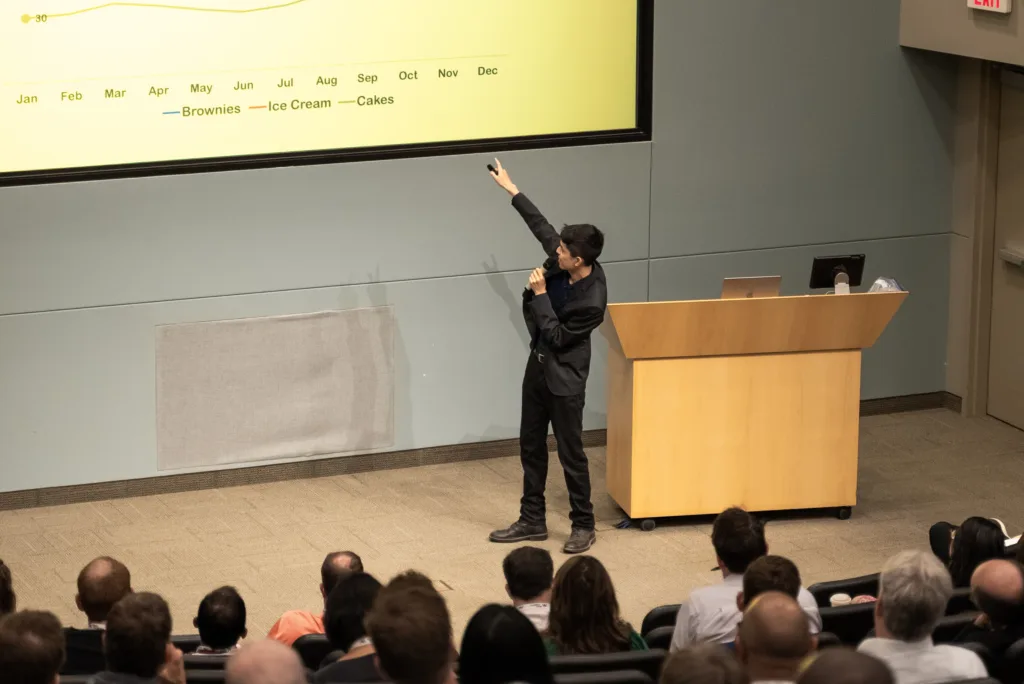If you’ve ever attended a highly technical presentation and felt like outrageously and loudly yawning a few seconds in, you are not alone.
Technical presentations suffer from being overloaded with information and detail, a lot of which just confuses and overwhelms the audience.
But consider the perspective of the speaker. They want to provide as much value as possible in the limited time they’re allotted, and see boredom as a necessary evil.
I’m here to tell you it doesn’t have to be that way.
In this article I will overview the method you should use to build presentations so that you avoid giving unnecessary detail and instead provide maximum, relevant value for your audience.
- Don’t start at the beginning
- Be careful about starting in the middle
- Consider starting at the end
- Summary
Don’t start at the beginning
Many presenters I work with want to start creating their presentation from the beginning or introduction. It seems logical. That’s how we eventually deliver the presentation: beginning – middle – end
But consider this case study:
Consider you’re a manager in a streaming service company like Netflix, which uses an algorithm to recommend new movies to its subscribers. You want to make an update to the algorithm, which would involve: ‘
- Higher short-term costs to acquire new data and train the model to give more accurate recommendations
- Hypothetically higher long-term revenue as a byproduct of increasing the algorithm’s accuracy
Imagine yourself trying to prepare for this kind of executive-level presentation
If you start preparing from the beginning, what is the first thing you’ll say? What will be on your first slide?
This is really hard for many people because it’s terrifying to stare at a blank page.
As an analogy, creating a presentation from the beginning is like walking in a completely dark tunnel:
- You have no idea what direction you’re going.
- So you just keep walking and walking, one foot after the other, in the hopes you don’t crash into anything.
In the same way for presentations, without a clear direction in sight, people just add more and more material and slides one after the other to try and get…somewhere.
- It may feel logical as you do it.
- But when you present, you realize the whole thing is bloated, unstructured, and aimless: the bane of so many technical presentations.
Let’s consider the next alternative: starting in the middle
Be careful about starting in the middle
By starting in the middle or body of our presentation, we no longer have to worry about the “right” or “best” way to introduce our topic. Now we can just focus on the “meat” of our material and what we find most important to discuss.
To convince the CEO to sign off on our proposal for the algorithm update, we might focus on how the algorithm gives better predictions and the experiments we conducted to validate our recommendation.
With that core established, we then start building out
We figure if the most important idea is how the algorithm gives better predictions, the CEO should receive some context beforehand to understand why this topic is important:
- So we add a prior section talking about the current poor performance of the algorithm…
- Aha! That could make a good introduction.
And then we figure the CEO would want to know next steps:
- So we add a follow-up section talking about how to integrate the update into the algorithm and how much that would cost…
- Fantastic! It looks like we have a logical flow of points.
But…this all falls apart with what I’m about to point out next
What you consider most important about your material is frequently NOT what your audience finds most important about it.
The CEO in this example does not want to know how the algorithm works:
- They just want to know what benefits it can provide the company
- And how much more money it will help the company make.
If you start preparing for your presentation in the middle – in the “meat” – there is a chance you may become lost in what you want to talk about most, not what your audience needs to hear.
And that will result in a lot of excess detail and explanation that weighs the presentation down into boredom oblivion: what so many technical presentations feel like.
Let’s consider the next alternative: starting at the end
Consider starting at the end
When I say “start at the end”, I mean think about what specific action you want people to take based on your presentation. A presentation, after all, is useless, if the information goes in one ear and out the other. Think about what people should do differently once they hear what you have to say.
In this case study, we want the CEO to sign off on our proposal. Perfect, we have our ending.
Now we can work backwards
- If we want the CEO to sign off on our proposal, we should tell them how much more money it will help the company make (because we figure that’s what the CEO cares most about).
- Then we walk backwards another step and say, “If the CEO hears how much more money the proposal will make, they’ll want to understand why it is able to achieve such amazing results”
- So we include a previous section on what benefits the new algorithm update will provide.
Continuing this exercise, we realize the topic of “how the algorithm works” is very, very far back in the priority ladder. It is one of our audience’s lowest priorities. And for that reason, it should either be excluded entirely, placed in the appendix, or mentioned briefly if absolutely necessary.
By building your presentation based on your audience’s desired action and cutting out everything else, that’s how you end up with a presentation that isn’t unstructured or weighed down by excessive detail. You end up with a presentation that hits everything your audience needs.
For more information on the science behind storytelling, read more here.
For more information on what defines a “good presentation”, read more here.
For an example of a talk created using this process, you can check out my TEDx talk below:
Summary
When you need to prepare a technical presentation, maximize engagement and minimize boredom by building it in a very specific way:
Be careful about preparing by starting at the beginning, because you might not yet have a clear direction or structure for your material.
Be careful about preparing by starting in the middle, because you might focus on what’s important to you, not what’s important to your audience.
Consider preparing by starting at the end with the action you want the audience to take. Then build backwards. In this way, you always keep their highest priority needs at the top of your mind.
If you’re looking for further guidance on how to differentiate your communication skills and stand out in the workplace, reach out to me here.



